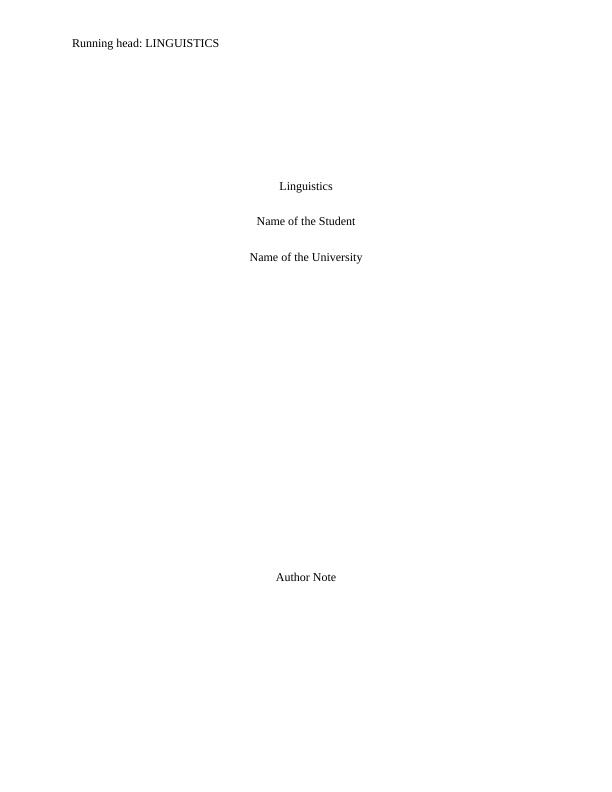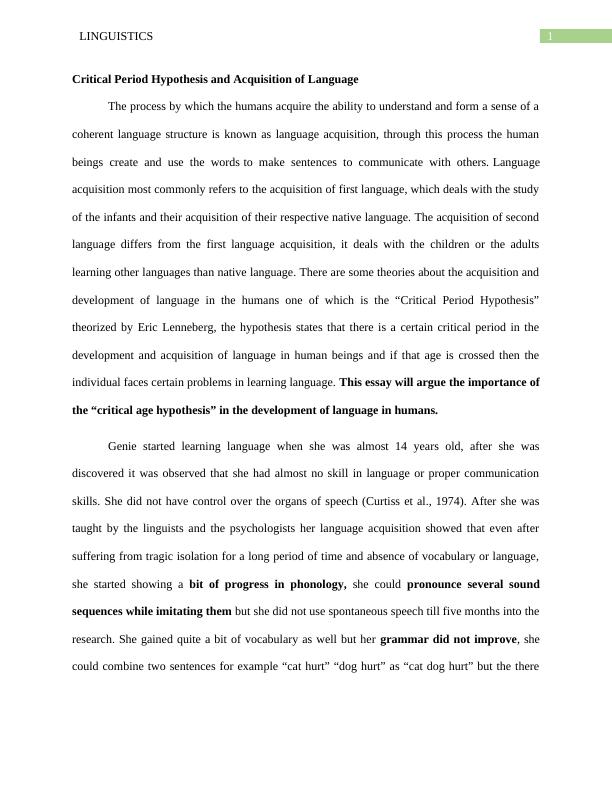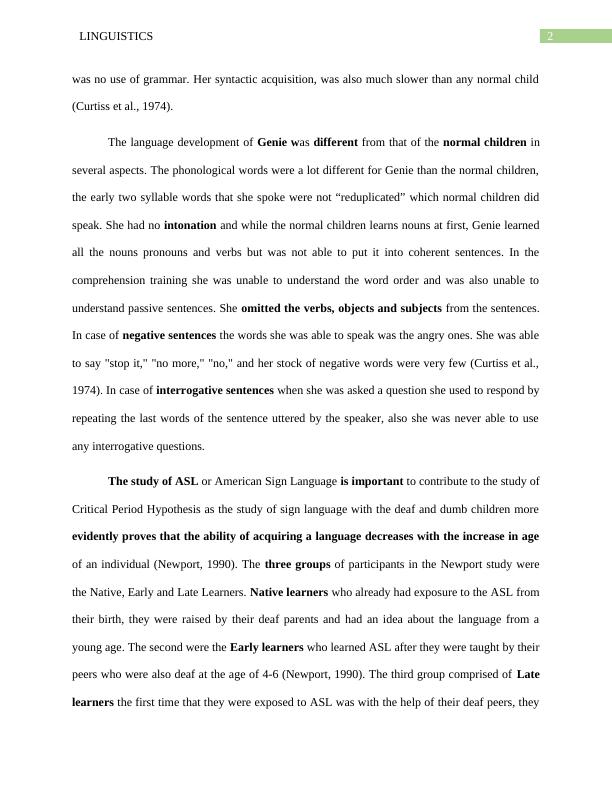Critical Period Hypothesis and Acquisition of Language
Added on 2023-06-15
6 Pages1545 Words396 Views
Running head: LINGUISTICS
Linguistics
Name of the Student
Name of the University
Author Note
Linguistics
Name of the Student
Name of the University
Author Note

1LINGUISTICS
Critical Period Hypothesis and Acquisition of Language
The process by which the humans acquire the ability to understand and form a sense of a
coherent language structure is known as language acquisition, through this process the human
beings create and use the words to make sentences to communicate with others. Language
acquisition most commonly refers to the acquisition of first language, which deals with the study
of the infants and their acquisition of their respective native language. The acquisition of second
language differs from the first language acquisition, it deals with the children or the adults
learning other languages than native language. There are some theories about the acquisition and
development of language in the humans one of which is the “Critical Period Hypothesis”
theorized by Eric Lenneberg, the hypothesis states that there is a certain critical period in the
development and acquisition of language in human beings and if that age is crossed then the
individual faces certain problems in learning language. This essay will argue the importance of
the “critical age hypothesis” in the development of language in humans.
Genie started learning language when she was almost 14 years old, after she was
discovered it was observed that she had almost no skill in language or proper communication
skills. She did not have control over the organs of speech (Curtiss et al., 1974). After she was
taught by the linguists and the psychologists her language acquisition showed that even after
suffering from tragic isolation for a long period of time and absence of vocabulary or language,
she started showing a bit of progress in phonology, she could pronounce several sound
sequences while imitating them but she did not use spontaneous speech till five months into the
research. She gained quite a bit of vocabulary as well but her grammar did not improve, she
could combine two sentences for example “cat hurt” “dog hurt” as “cat dog hurt” but the there
Critical Period Hypothesis and Acquisition of Language
The process by which the humans acquire the ability to understand and form a sense of a
coherent language structure is known as language acquisition, through this process the human
beings create and use the words to make sentences to communicate with others. Language
acquisition most commonly refers to the acquisition of first language, which deals with the study
of the infants and their acquisition of their respective native language. The acquisition of second
language differs from the first language acquisition, it deals with the children or the adults
learning other languages than native language. There are some theories about the acquisition and
development of language in the humans one of which is the “Critical Period Hypothesis”
theorized by Eric Lenneberg, the hypothesis states that there is a certain critical period in the
development and acquisition of language in human beings and if that age is crossed then the
individual faces certain problems in learning language. This essay will argue the importance of
the “critical age hypothesis” in the development of language in humans.
Genie started learning language when she was almost 14 years old, after she was
discovered it was observed that she had almost no skill in language or proper communication
skills. She did not have control over the organs of speech (Curtiss et al., 1974). After she was
taught by the linguists and the psychologists her language acquisition showed that even after
suffering from tragic isolation for a long period of time and absence of vocabulary or language,
she started showing a bit of progress in phonology, she could pronounce several sound
sequences while imitating them but she did not use spontaneous speech till five months into the
research. She gained quite a bit of vocabulary as well but her grammar did not improve, she
could combine two sentences for example “cat hurt” “dog hurt” as “cat dog hurt” but the there

2LINGUISTICS
was no use of grammar. Her syntactic acquisition, was also much slower than any normal child
(Curtiss et al., 1974).
The language development of Genie was different from that of the normal children in
several aspects. The phonological words were a lot different for Genie than the normal children,
the early two syllable words that she spoke were not “reduplicated” which normal children did
speak. She had no intonation and while the normal children learns nouns at first, Genie learned
all the nouns pronouns and verbs but was not able to put it into coherent sentences. In the
comprehension training she was unable to understand the word order and was also unable to
understand passive sentences. She omitted the verbs, objects and subjects from the sentences.
In case of negative sentences the words she was able to speak was the angry ones. She was able
to say "stop it," "no more," "no," and her stock of negative words were very few (Curtiss et al.,
1974). In case of interrogative sentences when she was asked a question she used to respond by
repeating the last words of the sentence uttered by the speaker, also she was never able to use
any interrogative questions.
The study of ASL or American Sign Language is important to contribute to the study of
Critical Period Hypothesis as the study of sign language with the deaf and dumb children more
evidently proves that the ability of acquiring a language decreases with the increase in age
of an individual (Newport, 1990). The three groups of participants in the Newport study were
the Native, Early and Late Learners. Native learners who already had exposure to the ASL from
their birth, they were raised by their deaf parents and had an idea about the language from a
young age. The second were the Early learners who learned ASL after they were taught by their
peers who were also deaf at the age of 4-6 (Newport, 1990). The third group comprised of Late
learners the first time that they were exposed to ASL was with the help of their deaf peers, they
was no use of grammar. Her syntactic acquisition, was also much slower than any normal child
(Curtiss et al., 1974).
The language development of Genie was different from that of the normal children in
several aspects. The phonological words were a lot different for Genie than the normal children,
the early two syllable words that she spoke were not “reduplicated” which normal children did
speak. She had no intonation and while the normal children learns nouns at first, Genie learned
all the nouns pronouns and verbs but was not able to put it into coherent sentences. In the
comprehension training she was unable to understand the word order and was also unable to
understand passive sentences. She omitted the verbs, objects and subjects from the sentences.
In case of negative sentences the words she was able to speak was the angry ones. She was able
to say "stop it," "no more," "no," and her stock of negative words were very few (Curtiss et al.,
1974). In case of interrogative sentences when she was asked a question she used to respond by
repeating the last words of the sentence uttered by the speaker, also she was never able to use
any interrogative questions.
The study of ASL or American Sign Language is important to contribute to the study of
Critical Period Hypothesis as the study of sign language with the deaf and dumb children more
evidently proves that the ability of acquiring a language decreases with the increase in age
of an individual (Newport, 1990). The three groups of participants in the Newport study were
the Native, Early and Late Learners. Native learners who already had exposure to the ASL from
their birth, they were raised by their deaf parents and had an idea about the language from a
young age. The second were the Early learners who learned ASL after they were taught by their
peers who were also deaf at the age of 4-6 (Newport, 1990). The third group comprised of Late
learners the first time that they were exposed to ASL was with the help of their deaf peers, they

End of preview
Want to access all the pages? Upload your documents or become a member.
Related Documents
Case Study Language Developmentlg...
|16
|5277
|393
Assignment On Language Acquisitionlg...
|9
|2818
|380
